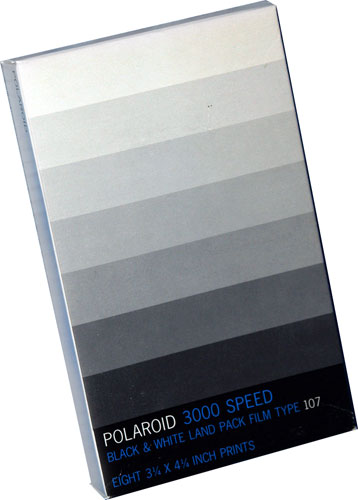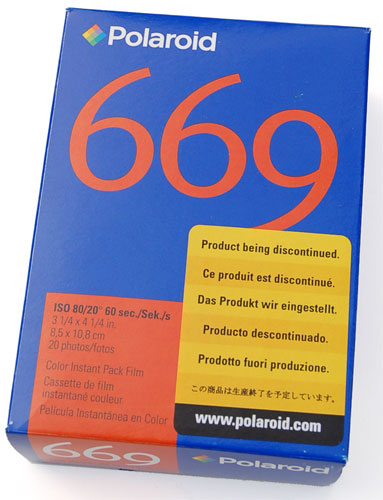| 100/660 Series film discontinued Choose a film to see more information about it. |
|
|---|---|
Type 668 (Polacolor ER) |
|
Type 672 (Polapan Pro 400) |
|
Type 679 (Polacolor Pro 100) |
|
Type 689 (Pro Vivid) |
|
Type 664 (Polapan Pro 100) |
|
Polacolor ID (ID-UV) |
|
Packfilm Films
This list only include Polaroid branded materials. For a listing of some other films not listed here, such as the compatible Fuji films, see the FAQ page.
The following technical information is useful for specifics concerning each film.
Unless otherwise noted, all 100/660-Series Land Pack Films have the following characteristics in common:
- Each pack produces 8 prints.
(many changed to 10 later) - Actual image area: 2 7/8" x 3 3/4" (7.2 x 9.5 cm)
100/660-series films (and others included in this category) are used by Polaroid Packfilm Cameras, as well as other photographic equipment having a Polaroid #405 (Fuji PA-145 equivalent) film back or other compatible back.
Produced: 1974-1977 / Original Price: $?.??
- Film speed: ASA 75
- Panchromatic, B&W
- Produces both a positive print and a reusable negative.
- 60-second development. Negative requires an extra 'clearing' step after development. Sodium sulfite (not included with film) required for negative clearing bath.
Note: Renamed to Type 665 in 1977 as part of Polaroid's then-new Professional Pack Film line.
Produced: 1963-2000 (?) / Original Price: $1.92
- Film speed: ASA 3000
- Panchromatic, B&W
- 15-second development.
Notes: This, along with Type 108, was one of the original two film types introduced with the Model 100 (Automatic 100) pack camera.
Modern coaterless equivalent is Type 667.
Produced: 1978-199? / Original Price: $?.??
- Film speed: ASA 3000
- Panchromatic, B&W
- Coaterless, 30-second development.
Notes: Was offered simultaneously with Type 667, but 107C was geared towards mass-market retailers, while 667 was primarily sold by full-service camera stores. 107C was dropped in the mid 1990's, presumably because not very many mass-merchandisers were stocking Polaroid pack films any more. At or about the same time, Type 667 went from 8 prints per pack to 10 prints per pack.
Produced: 1963-2002 (?) / Original Price: $4.38
- Film speed: ASA 75
- Color
- 60-second development
Notes: While nominally ASA 75, most (if not all) Type 108 film packs made before the early 1970's bore a sticker directing the user to set the Lighten/Darken control on the camera one small mark towards Lighten. Doing this would essentially set the exposure system for about ASA 60.
Like Type 48 (see notes), this film was supplied with self-adhesive mounting cards for a while. I'm not sure when the related 'print curl' problem was solved, but was probably early 1970's or so.
In 1975, was replaced by new "Polacolor 2" film under the same type number. This was an improved film based on SX-70 technology, and used a new negative stock made by Polaroid themselves. [Before this point, Eastman Kodak was contracted by Polaroid to produce the 'negative' material for Polaroid color films. This changeover was a contributing factor to the discontinuance of Type 48 rollfilm at about the same time. (See the notes for Type 48 for more details)] Eventually the "Polacolor 2" designation was dropped, but remained the same film.
The transition to "Polacolor 2" may or may not be related to the end of the one-mark-towards-Lighten stickers and the solution to the 'print curl' problem; I really don't know.
As with Type 107C, this film essentially became the mass-market version of an otherwise equivalent 'professional' film (Type 668 in this case). [Type 668 was supplanted by-- and eventually replaced by-- an improved film called Type 669.]
Produced: 1977- 2002 (?) / Original Price: $?.??
- Film speed: ASA 3000
- Panchromatic, B&W
- 15-second development.
Notes: The literature for this film suggests it is intended for CRT recording-- but it has normal contrast.
A new Type 84 (no leading zero) film was introduced in 2003, but this is an unrelated 80-series 'square'-format film.
Produced: 19??-???? / Original Price: $?.??
- Film speed: ASA 3000
- Low Contrast Panchromatic, B&W
- 15-second development.
Notes: Designed for CRT recording applictions requring low contrast.
Produced: 19??-199? / Original Price: $?.??
- Film speed: ASA 20,000
- High Contrast Panchromatic, B&W
- 30-second development
Notes: Yes, that's a film speed of twenty thousand, the fastest film Polaroid has ever offered. Unfortunately, it appears to have been discontinued as of around 1999/2000 or so. It is a very high contrast film, though, and difficult to use for general purpose photography. Designed for CRT/oscilloscope recording.
Produced: ????- Present / Original Price: $?.??
- Film speed: ASA 100
- Panchromatic, B&W
Produced: 1977- 2006 / Original Price: $?.??
- Film speed: ASA 75 (80)
- Panchromatic, B&W
- Produces both a positive print and a reusable negative.
- 60-second development. Negative requires an extra 'clearing' step after development. Sodium sulfite (not included with film) required for negative clearing bath.
Notes: Formerly called Type 105.
Package increased to 10 prints/negatives per pack in 2003.
Polaroid also used to sell (but discontinued long ago) a companion "clearing bucket" accessory for this film to aid in the negative "clearing" process. This rather well-designed product contains a removable plastic rack which can hold several negatives safely in the clearing solution without allowing them to come in contact with each other. In any case, the special 'bucket' is not necessary for clearing the negatives-- you can use plastic darkroom trays, tanks, or whatever. You can even use (if you're really careful!) Ziploc-style plastic bags if you want.
Produced: 1977- late '00s/ Original Price: $?.??
- Film speed: ASA 3000
- Panchromatic, B&W
- Coaterless, 30-second development.
Notes: Similar to Type 107C, which was offered simultaneously for several years.
Package increased to 10 exposures per pack in the mid-1990's.
Produced: 1977-199? / Original Price: $?.??
- Film speed: ASA 75
- Color
- 60-second development
Notes: Professional markets version of Type 108.
Produced: 198?- late '00s/ Original Price: $?.??
- Film speed: ASA 75 (80)
- Color
- 60-second development
Notes: Improved version of Type 108/668.
Package increased to 10 exposures per pack in the mid-1990's.
Produced: ????- late '00s / Original Price: $?.??
- Film speed: ASA 400
- Panchromatic, B&W
- Produces 10 prints per pack
Produced: 199?- 2003 / Original Price: $?.??
- Film speed: ASA 100
- Color
- 60-second development
- Produces 10 prints per pack
Notes: This is an improved version of Type 669, and bumped up slightly in speed in order to match popular conventional films.
This film, along with Type 689, has been replaced with Type 690 as of 2003.
Produced: 199?- 2003 / Original Price: $20.90 ?
- Film speed: ASA 100
- Color
- 60-second development
- Produces 10 prints per pack
Notes: This is an even further improved version of Type 669 and Type 679, and was Polaroid's top-end professional color pack film until the recent (2003) introduction of Type 690 (which replaces this film).
Produced: 2003- late '00s/ Original Price: $?.??
- Film speed: ASA 125
- Color
- 90-second development, no adjustment needed for ambient temperatures of at least 70°F / 21°C.
- Produces 10 prints per pack
- This film is not recommended for image transfers or emulsion lift transfers.
Notes: This is an all-new Professional color film, which not only has further improvements in color rendition and contrast, but also has a re-engineered chemistry that makes development (almost) self-timing. While all Polaroid integral films are (by necessity) self-timing, this is the first Polaroid peel-apart film to have this feature.
Produced: 198?- 199? / Original Price: $?.??
- Film speed: ASA 80
- Color
- 60-second development
- Produces 8 color transparencies (slides) per pack
Notes: Designed for making transparencies to be used on an overhead projector. Polaroid even offered special cardboard frames to aid in handling the slides.
Produced: 198?- late '00s / Original Price: $?.??
- Film speed: ASA 64 (tungsten)
- Color
- 60-second development
Notes: Similar to Type 669, but color balanced for tungsten lighting.
Produced: 199?- late '00s/ Original Price: $?.??
- Film speed: ASA 80
- Color
- 60-second development
Notes: Similar to Type 669, but has a special security "tracer" overlay imprinted over the print surface and viewable only under UV light (i.e. a blacklight).




Option-al Landlist
Rollfilm
Cameras
Accessories
Film
Packfilm
Cameras
Accessories
Film
SX-70
Cameras
Accessories
Film
600/779
Cameras
Accessories
Film
Spectra
Cameras
Accessories
Film
Oddballs
Cameras
Accessories
Film
Polavision
Cameras
Accessories
Film
All Films
All Cameras
All Accessories
The FAQ
Contact me…